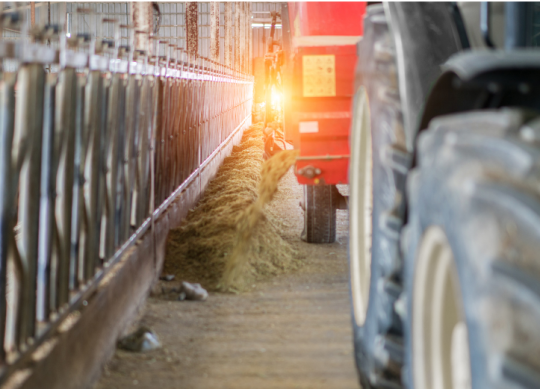Feed efficiency gains rule the day
Business-focused dairies are wired to think in terms of controlling costs per hundredweight. This mindset is no different than those managing businesses that manufacture tractors, air conditioners, or sneakers. Producing more is irrelevant if we’re not economically efficient in doing so.
Historically, we’ve been enamored with dairy farm output. Producing more milk per cow has equated to bragging rights, and milk per cow has been the performance indicator we’ve tracked closely . . . but times have changed.
Efficiency gains are now more economically and environmentally impactful than output gains. Driving this point home, recent survey data shared by Vita Plus’s Stacy Nichols showcased a 7-pound range in dry matter intake across 20 herds shipping greater than 6.7 pounds of combined fat and protein per cow per day.
This realization is tough to grasp but sets the stage for the future. Even among the highest output dairies, there is a range of 75 cents to $1 per hundredweight in margin opportunity tied to feed intake. After coming to grips with this fact, the next questions become:
What’s contributing to the range in economic performance?
How are the best getting better?
Know your numbers
With 50% or more of dairy costs per hundredweight rooted in feed, let’s stay focused on dry matter intake (DMI). Referencing back to the May 2023 Hoard’s Dairyman article, “There are massive feed savings out there,’’ I dove into DMI. I discussed the caveats and challenges to measuring DMI on the farm. The article clearly struck a chord because there were several high-gain conversations that followed the issue hitting mailboxes.
One interesting comment from a fellow industry professional was that he estimated up to half the dairies he worked with did not have rock-solid DMI data. If your dairy is among this 50%, look back to the article from earlier this year to solidify your feed accounting math and firm up your DMI estimates. This is no easy task. Bring in your consultants or partners to help get it done. Improving margins through improved feed conversion efficiency starts with having firm DMI data connected to energy-corrected milk output.
Transitioning to the feed conversion efficiency topic and with DMI and inputs in mind, I often reference Mary Beth de Ondarza and Juan Tricarico’s review article in this area. The article is excellent and extensive, well beyond what we’ll cover here. With that being said, here are a few feed efficiency factors to consider from their review and some of my thoughts to start conversations on your dairy.
Fiber digestibility: More digestible fiber equates to greater intake potential; however, higher intake does not always equate to greater feed conversion efficiency. The physical fiber characteristics interact with fiber digestibility to affect intake and efficiency. Fiber digestibility needs to be balanced against diet physical form to optimize feed conversion.
Starch digestibility: Higher starch diets not only improve feed conversion efficiency to a point through more energy intake but also can enhance energy feedback mechanisms. Michigan State University’s Mike Allen’s hepatic oxidation theory gets into this in some depth. Beyond starch and forage-to-grain levels, starch digestibility may also influence feed intake. Ask your nutritionist for their thoughts and expect new insights in the near future as research continues in this area of dairy nutrition. I firmly contend that poor grain and starch digestibility are related to less than stellar feed conversion.
Supplemental fat: Adding supplemental fat to the diet can affect intake in a few ways. First, fat can boost diet energy density to meet production needs. Fat can also affect intake through the “full feeling,” just like how you feel after eating a rich meal. Specific fatty acids, such as oleic acid or omega-3 fatty acids, can also improve animal health, thereby lessening energy diverted to maintenance or recovery. The more energy available for production, the more efficient the animal.
Feed additives: This is a deep and constantly evolving area, but there are feed ingredients that can affect intake and feed conversion efficiency.
Precision feeding: Delivering feed and nutrients consistently and precisely relative to intakes and energy demands is an area where we stand to advance considerably. New technologies are on the horizon to help us manage dry matter intake more accurately as well as deliver targeted nutrients more precisely. Exciting new research from Cornell University’s Jorge Barrientos-Blanco and Kristan Reed has shown that a more precise nutrient supply on commercial dairies equates to production and feed conversion efficiency gains.
Feed storage losses: The last area that can rob dairies of feed conversion stems from the feed center and silo before the feed is mixed and delivered. Excessive fermentation and storage shrink means that more feed needs to be harvested or bought to feed the herd and produce a hundredweight of milk. Think of this like a leaky fuel tank on your truck. The engine is running fine, but the leak results in having to fill up with more fuel than the engine actually burns. Feed losses that occur prior to reaching the feedbunk raise feed costs per hundredweight and shrink margins.
Pick up the conversation from here with your trusted advisers. Look to better account for and manage the input side of your margin per hundredweight equation, recognizing that there may be up to $1 per hundredweight in opportunity tied to efficiency gains.
Hoards Dairyman, Dr. John Goeser Rock River Lab



